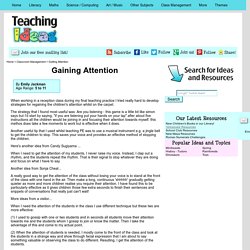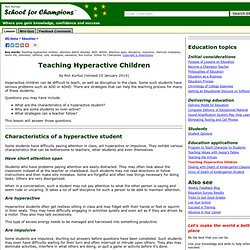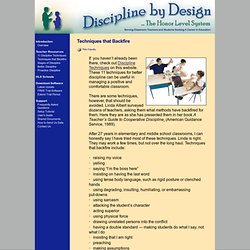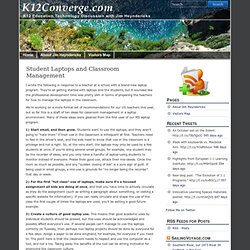

Gaining Attention. By Emily Jackman Age Range: 5 to 11 When working in a reception class during my final teaching practice I tried really hard to develop strategies for regaining the children's attention whilst on the carpet.

The strategy that I found most useful was: Are you listening - this game is a little bit like simon says but I'd start by saying, "if you are listening put your hands on your lap" after about five instructions all the children would be joining in and focusing their attention towards myself. this methos does take a few moments to work but is effective when it does. Another useful tip that I used whilst teaching PE was to use a musical instrument e.g. a jingle bell to get the children to stop. This saves your voice and provides an effective method of stopping the children. Here's another idea from Candy Sugiyama ... When I need to get the attention of my students, I never raise my voice.
Another idea from Sonja Cheal... Teaching Hyperactive Children - Succeed in Education: School for. SfC Home > Education > Key words: Teaching hyperactive children, attention deficit disorder, ADD, ADHD, attention span, disruptive, impulsive, chemical imbalance, home life, television, caffeine, cola, strategies, education, Ron Kurtus.

School for Champions. Copyright © Restrictions by Ron Kurtus (revised 10 January 2014) Hyperactive children can be difficult to teach, as well as disruptive to the class. Questions you may have include: What are the characteristics of a hyperactive student? This lesson will answer those questions. Characteristics of a hyperactive student Some students have difficulty paying attention in class, act hyperactive or impulsive. Have short attention span Students who have problems paying attention are easily distracted. When in a conversation, such a student may not pay attention to what the other person is saying and seem rude or uncaring. Are hyperactive This type of excess energy needs to be managed and harnessed into something productive. Top 5 Classroom Management Strategies. Strategies for Good Classroom Management My biceps don’t bulge and my hair is blond.

Intimidation is not my weapon. I am a veteran teacher with 17 years of experience. I have taught senior auto mechanics Shakespeare. In addition to high school students, I have taught middle school students who have had ADHD, students who had parents in jail and students with their own parole officers. In the real world, students come from all walks of life. Of course, students know the classroom rules and school rules. S Guide Classroom Management Page. Discipline by Design. If you haven’t already been there, check out Discipline Techniques on this website.

These 11 techniques for better discipline can be useful in managing a positive and comfortable classroom. There are some techniques, however, that should be avoided. Linda Albert surveyed dozens of teachers, asking them what methods have backfired for them. Here they are as she has presented them in her book A Teacher’s Guide to Cooperative Discipline, (American Guidance Service, 1989). After 27 years in elementary and middle school classrooms, I can honestly say I have tried most of these techniques. . · raising my voice · yelling · saying “I’m the boss here” · insisting on having the last word · using tense body language, such as rigid posture or clenched hands · using degrading, insulting, humiliating, or embarrassing put-downs · using sarcasm · attacking the student’s character.
Behavior Charts For Teachers, Classroom Management Printables. SEC Teachers Network: Classroom Management and Education of Boys. A training program titled during the month of April.

THe training was organized by the SEC and provided by trainers from the Victorian Department of Education and Early Childhood Development. The program focused on a set of highly effective practical strategies for female teachers to use in managing a boys only environmnet of learning and teaching. Participants were assisted to develop and select appropriate teaching strategies and review their teaching practice with a particular focus on the teachers' role in creating and managing a classroom learning envrinoment that facilitates imporved student outcomes.
There has been an emphasis throughout the program on how students learn and the implications of this knowledge for pedagogy in the classroom. Participants were expected to reflect on and evaluate their own practice in order to refine and improve their teaching with the program. Specific areas explored in this program included: The Victorian education context. Classroom Management: A-Z Resources. Student Laptops and Classroom Management. I wrote the following in response to a teacher at a school with a brand-new laptop program.

They’re all getting started with laptops and the students, but it sounded like the professional development time was pretty slim in terms of preparing the teachers for how to manage the laptops in the classroom. We’re working on a more formal set of recommendations for our US teachers this year, but so far this is a draft of ten ideas for classroom management in a laptop environment. Many of these ideas were gleaned from the first year of our MS laptop program. 1) Start small, and then grow. Students want to use the laptops, and they aren’t going to “hate them” if their use in the classroom is infrequent at first. 2) For the first “full class” use of laptops, make sure it’s a focused assignment all kids are doing at once, and that you have time to actively circulate as they do the assignment (such as writing a paragraph about something, or visiting a specific website for information).